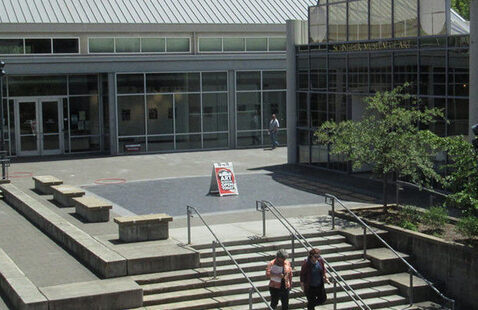“Bookstore: Is it really ripping us off?” by Alison Berliner (The Siskiyou, Oct. 13, 1992)
Does the bookstore at Southern Oregon State College overcharge students who purchase new or used books? Does the bookstore cheat people out of a decent buyback price as well? Many students at SOSC believe so.
“They’re ripping us off,” exclaims SOSC student Ray Kato. “They jack the price up from what they pay wholesale by up to $20; then they buy them back at the end of the term for half the price of the new, thus making $30 or $40 off you.”
But Project Bookstore Awareness through Student Education is showing students the facts of how the bookstore runs and operates. Project B.A.S.E. was founded by students Susanna Enghouse and Andi Redd. Enghouse says once students become educated, “They can make an objective decision about how the bookstore operates.”
Project B.A.S.E. began when their Small Group Communication class had an assignment to find a problem on campus and propose a solution to it. Their problem was high book prices; Project B.A.S.E. was their solution.
Student Jenny Duncan says, “I don’t think they should sell books above cost. They should find another way to make a profit with their merchandise.”
The fact is SOSC’s bookstore is self-sufficient and receives no tax money. “We just wish that students could understand that they are giving SOSC the best prices they can and break even at the same time. Most students don’t even know that the bookstore is a non-profit organization and that they promise money every year to lower the cost of incidental fees to the students,” commeneted Enghouse and Redd.
The bookstore is required to make a 3 to 5 percent margin and pay all operating expenses, salaries and various other assessments without help from the state. These expenses need to be paid in order for the bookstore to continue functioning efficiently. The remainder of the profit (about $40,000 a year) goes to offset incidental fees which all students are required to pay.
According to Western College Bookstore Association, the SOSC bookstore is in the top 5 percent nationwide in providing students with used books. Over 50 percent of used books available come from SOSC students. SOSC charges less for books than over 75 percent of all other bookstores.
Enghouse and Redd have dedicated time to Project B.A.S.E., while at the same time are receiving practicum credits. They have put together a survey to give students twice a year, asking what they know about the bookstore. With the information they obtain, they will provide the information that students lack using flyers, video and air time.
Enghouse and Redd also want to inform people about the buyback process. During “buyback” the following things may happen: You receive half of new retail price, if the book was adopted for the next term. If not adopted or if more copies are not needed, you are offered the current market value of the book. “We don’t get a profit for this service,” says Karen Green, bookstore manager, “What are we gonna do with a book we can’t use … it’s a student service. Books are expensive and I can’t do anything about that,” Green continued, “But I will try to get the book at the least possible price for students.”
“I think teachers should try harder to get cheaper books and keep the same text until it is updated,” says student Samantha Ginsburg.
Enghouse told them how valuable their textbooks are and to keep a good eye on them, because they could get stolen by other students wanting cash at “buyback” time.
According to Green, “Most larger schools have rebate programs, where students save their receipts. Then they turn in the receipts for a rebate, but this would not benefit everyone.”
Receipts can easily be lost. Green says the bookstore has adopted the “most equitable way to go about book sales by offsetting incidental fees all students are required to pay.”
Green says, “I am very open to talk to people and want to share our policies with students.”


